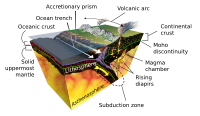
Photo from wikipedia
Blueschist is a regional metamorphic rock formed under high-pressure (HP) low-temperature (LT) conditions. It is formed in the subduction zone environment with low geothermal gradients (4–14°C km−1), and is characterized… Click to show full abstract
Blueschist is a regional metamorphic rock formed under high-pressure (HP) low-temperature (LT) conditions. It is formed in the subduction zone environment with low geothermal gradients (4–14°C km−1), and is characterized by the presence of HP/LT index minerals like glaucophane, lawsonite, aragonite, jadeite, and deerite. In general, blueschist-facies rocks are stable in subduction zones at depths of 30–60 km, and transform to eclogite-facies rocks at greater depths. The preservation of blueschists requires a fast exhumation rate. Based on protolith and tectonic setting, blueschists can be grouped into Type-A and Type-B, but some metasomatic blueschists also occur. Blueschist belts distribute mainly as bands along the margins of orogenic belts, and their occurrences within cratons are very limited. Precambrian blueschists, of which the oldest ones are about 800–700 Ma in age, are rare; most of the exposed blueschist terranes are of post-Paleozoic metamorphic age. As diagnostic evidence of ancient subduction zones, blueschist plays an important role in understanding plate tectonics. Blueschist-eclogite transition at cold subduction zones involves dehydration reactions and fluid release, which are of great importance in facilitating slab-mantle wedge water and element recycling, generating arc magmatism, and triggering intermediate-depth earthquakes in the subducting slab. Metamorphic P-T paths of blueschists and associated rocks provide key information on constraining the onset of the subduction initiation and subsequent geodynamic evolution. As a cold geothermal indicator, the emergence of blueschist offers robust evidence for the start of modern plate tectonics on the Earth. Blueschist-facies metamorphism still represents an important research direction in metamorphic geology, which requires further investigations on determining the beginning of plate tectonics, constraining phase-transition processes, and constructing a global blueschist database.
Journal Title: Science China Earth Sciences
Year Published: 2020
Link to full text (if available)
Share on Social Media: Sign Up to like & get
recommendations!